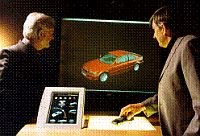EASY2C (ca. 2000)


Design plays an important role when developing new products. In the past, the design review process required physical models to be constructed at the original scale and with the planned design of the surface, which involved high expense in both time and cost. Today's modern technologies in terms of computers and presentation make it possible to render photorealistic images presented at any given perspective in real time. The object is shown in a "virtual reality", which is how this phrase was coined in the first place. The various possibilities of presentation are used for example by the automotive industry, where the "Virtual Showroom" has become a standard facility. So far a technical assistant has been required to create the desired views of the virtual models.
Man-machine interface
Therefore, for several years, the automotive industry has been looking for appropriate man-machine interface that is as easy to operate as possible, even by untrained staff. Many interfaces have been examined and evaluated as unsuitable, from keyboard and dataglove to head mounted display. A first marketable approach for these demands to synthetic image presentation was designed in 1999 at the DLR Institute in cooperation with the licencee Realtime Technology A.G. (RTT), Munich. The special feature of the new technology is that anyone can operate it without the need for training or prior knowledge. The product is now marketed by RTT as "EASY2C" (pronounce: easy to see).
Mode of Operation
This new technology makes it possible to experience objects before their physical existence. The user moves a tangible object, the input medium, over a glass plate to create a view of the virtual model, which is displayed either on a projection screen or a monitor, where it follows the hand movements of the user. Moreover, the user can adjust a variety of options interactively.
Technical components
The shape of the input medium, be it a model car, a computer mouse or a cuboid, is irrelevant for the function of the system. The objects serving as input media have markers on their underside. They are moved by hand across a glass plate and detected by a video camera under the glass. The markers function as both, object reference points and identifiers. The evaluation of the video image is performed on a standard computer. According to this information, computer graphics calculates and displays a virtual image of the object in the given pose.
Using a touch-screen, the operator can achieve a variety of different ways of presentation, such as selecting the model type and color, as on a rotating plate, and varying the tilt angle which changes according to body height.
Advantages
The ease of use and the closeness to reality of the experienced virtual object contributes considerably to the potential of this technology. For the immediate spatial relationship between the physical input medium and the virtual model makes the user instantly grasp the proper usage of the system and enables instant operation.
Innovation transfer
This technology was first introduced to the public on the 12th July 2000 in Ingolstadt at a trade fair for automotive suppliers. The first customer to use "EASY2C" was BMW Group Design Development at the Paris Autosaloon 2000 trade fair, where design studies for the new BMW MINI were presented. The enormous potential of the new technology was fully exploited by virtually exhibiting vehicles which did not yet exist. Thus visitors were able to see the already existing MINI COOPER or designs for a new MINI convertible, a MINI truck or a MINI pick-up, and choose their desired views themselves. In future, such techniques will also be used in marketing to help the customer decide whether or not to buy a car, a piece of furniture, or a house.

